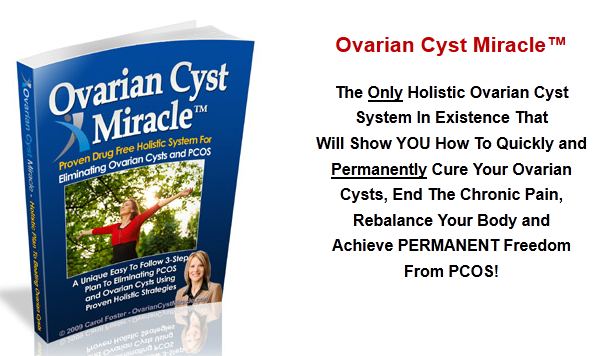Ovarian Cysts Symptoms
Symptoms of Ovarian Cyst
What are ovaries?
Ovaries are the two little organs located on either side of the woman’s uterus. These produce hormones, including estrogen, which trigger menstruation. Once a month, ovulation occurs, where the ovaries release an egg that makes its way down the fallopian tube.
>>Click Here To Download Ovarian Cyst Miracle Program<<
(Comes with a 60 Days 100% Money Back Guarantee)
So what causes ovarian cyst?
Cysts are small fluid-filled sacs that can form in the ovaries. These cyst are particularly common during the childbearing years.
Several different types of ovarian cysts exist. The most common, the functional cyst – which forms during ovulation. That formation happens when either the egg is not released or the sac follicle in which the egg forms does not dissolve after the egg is released.
Other types of cysts include:
Polycystic ovaries – In polycystic ovary syndrome (PCOS), the follicles in which the eggs normally mature fail to open and cysts form.
Endometriosis – In women with endometriosis, tissue from the lining of the uterus grows in other areas of the body. This includes the ovaries. It can be very painful and can affect fertility.
Cystadenomas – These cysts form out of cells on the surface of the ovary. They are often fluid-filled.
Dermoid cysts – This type of cyst contains tissue similar to that in other parts of the body. That includes skin, hair, and teeth.
Ovarian Cysts
Ovarian cysts are sacs that are filled with either a fluid or a fluid and solid mixture. They can occur either inside of or on the exterior of an ovary. While cysts can burst, hemorrhage or induce pain requiring surgery, most of the time, they cause no harm and will disappear by themselves.
The presence of ovarian cysts can be detected by a mild stomach ache and an uncomfortable feeling of pressure in your abdomen. Mostly, these symptoms occur due to the irritation caused to the abdominal tissues by bursting cysts. Twisting of a cyst, which prevents the flow of blood to the ovary, can also result in painful situations.
A very common form of ovarian cyst would be the functional cyst. The functional cyst occurs when the normal sequence of events of the menstruation cycle go wrong in some way. Follicles, which are tiny structures, normally develop within the ovaries. These follicles hold an egg and are expected to make the hormones estrogen and progesterone.
Some of the symptoms you should look out for are pain during intercourse, irregular bleeding, putting on weight, a swollen stomach, a dull pain or ache on either or both sides of the pelvis. If a cyst becomes broken or twisted it can begin to bleed which can cause more severe problems such as vomiting, fever and extremely severe pain in the abdominal area.
Most ovarian cysts don’t produce any symptoms, and you may not even know you had one. Sometimes your doctor will find one when you have a pelvic exam and PAP. Sometimes, however, you will experience pain, a bloated feeling, irregular periods or spotting, problems urinating or having a bowel movement and/or fatigue.
The lower abdominal area may get sharp stabbing pain when an ovarian cyst ruptures. This acute pain is especially felt by those women, who haven’t had previous pain from the ovarian cyst before it ruptured. If the pain from the cyst was there before it ruptures, then if it ruptures, there may follow a slow increase of the pain.
There are many ways of ovarian cyst treatment (read Carol Foster’s Ovarian Cyst Miracle) and all of the ways have their advantages and disadvantages. The first but perhaps the most ineffective of ways is the conventional method of ovarian cyst treatment, the prescribing of pills by a doctor so as to decrease the pain and irritation while also trying to fight the cyst.
The method of treatment for an ovarian cyst is not confined on only one treatment method. It actually encompasses different medical and natural treatments depending upon the gravity of the cyst. Complex cyst on ovary contains solid and liquid components but the solid element has the tendency to become cancer.
Treatment for your cyst will depend on your age, the type of cyst, its location, size and speed of growth. Sometimes ovarian cysts can cause complications; they may rupture, which in turn may cause internal bleeding, shock or peritonitis. They may also become large enough to cause your ovaries to twist, which causes extreme discomfort.
Ovarian cysts are rarely malignant but can rupture and cause a lot of pain and discomfort. An ovarian cyst during pregnancy still needs to be carefully monitored and examined to ensure that pregnant women deliver their children without too much inconvenience.
How are ovarian cysts treated?
Most ovarian cysts will go away on their own. If you don’t have any bothersome symptoms, especially if you haven’t yet gone through menopause, your doctor may advocate ”watchful waiting.” The doctor won’t treat you. But the doctor will check you every one to three months to see if there has been any change in the cyst.
Birth control pills may relieve the pain from ovarian cysts. They prevent ovulation, which reduces the odds that new cysts will form.
Surgery is an option if the cyst doesn’t go away, grows, or causes you pain. There are two types of surgery:
Laparoscopy uses a very small incision and a tiny, lighted telescope-like instrument. The instrument is inserted into the abdomen to remove the cyst. This technique works for smaller cysts.
Laparotomy involves a bigger incision in the stomach – prefered technique for larger cysts and ovarian tumors.
>>Click Here To Download Ovarian Cyst Miracle Program<<
(Comes with a 60 Days 100% Money Back Guarantee)
